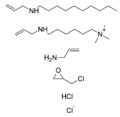Colesevelam: Difference between revisions
Created page with " {{intro}} Colesevelam is a nonabsorbed bile acid sequestrant that is used a therapy of hyperlipidemia and for the pruritus of chronic liver disease and biliary obstruction. C..." |
CSV import Tags: mobile edit mobile web edit |
||
| Line 14: | Line 14: | ||
{{cholesterol drugs}} | {{cholesterol drugs}} | ||
{{coststubd}} | {{coststubd}} | ||
<gallery> | |||
File:Colesevelam_structure.svg|Structure of Colesevelam | |||
File:Colesevelam.png|Colesevelam | |||
</gallery> | |||
Latest revision as of 02:03, 17 February 2025
Information about Colesevelam[edit]
Colesevelam is a nonabsorbed bile acid sequestrant that is used a therapy of hyperlipidemia and for the pruritus of chronic liver disease and biliary obstruction. Colesevelam has not been associated with clinically apparent liver injury.
Mechanism of action of Colesevelam[edit]
Colesevelam (koe" le sev' e lam) is a large, highly positively charged anion exchange resin that binds to negatively charged anions such as bile acids (as well as other organic compounds and some medications). The binding of bile acids to colesevelam creates an insoluble compound that cannot be reabsorbed and is thus excreted in the feces. Bile acids ordinarily undergo extensive (>95%) enterohepatic recirculation, being secreted in bile, acting as fat solubilizing compounds in the upper intestine, and then being reabsorbed in the distal small bowel. Chronic loss of bile acids results in a contraction in the total bile acid pool. The liver compensates for this decrease by increasing bile acid synthesis, which directly competes with cholesterol synthesis resulting in a decrease in serum levels. Some of the decrease in serum cholesterol may also result from inhibition of fat absorption by the binding of bile acids to colesevelam. Colesevelam
FDA approval information for Colesevelam[edit]
Colesevelam was approved for use in the United States in 2000 and is currently used largely as an adjunctive therapy when statins or other lipid lowering agents result in an inadequate decrease in cholesterol levels. Colesevelam is also approved as an adjunct to diet and exercise to improve glycemic control in type 2 diabetes. Colesevelam is available in tablets of 625 mg under the brand name of Welchol. The usual dose is three tablets twice a day, given with meals or six tablets once daily. Other drugs should be given 1 hour before or 4 to 6 hours after colesevelam. Colesevelam is administered in tablet form and does not have the problem of lack of palatability that is characteristic of other bile acid resins.
Side effects of Colesevelam[edit]
Side effects include abdominal discomfort, indigestion, nausea, flatuence and constipation.
Lipid lowering medications
- Niacin (Nicotinic Acid)
- Miscellaneous
-
Structure of Colesevelam
-
Colesevelam

